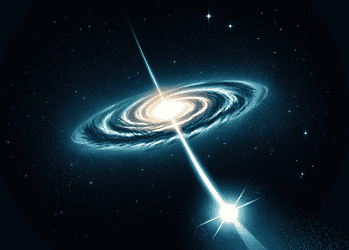If you happened to be alive 70,000 years ago, you might have witnessed an extremely rare event: a duo of rogue stars passing relatively close to the Sun — close enough to gravitationally disrupt the comets and asteroids in the outskirts of the solar system.

In a time when humans were just leaving Africa and Neanderthals were still around, two small reddish stars were approaching our solar system. We now call them Scholz’s star, after the astronomer who discovered them (Ralf-Dieter Scholz). The system is currently some 20 light-years away from Earth, but 70,000 years ago, it was much closer. A team of astronomers now analyzed the orbit of nearly 340 objects in the solar system with hyperbolic orbits (very open, not quite typical elliptical), finding that the trajectory of some of them was influenced by Scholtz’s star. They report that some comets and asteroids in the Oort Cloud — the outer limit of our solar system — were disrupted by the passing of the star.
“Using numerical simulations we have calculated the radiants or positions in the sky from which all these hyperbolic objects seem to come,” explains Carlos de la Fuente Marcos, who together with the other coauthors publishes the results in the MNRAS Letters journal.
“In principle,” he adds, “one would expect those positions to be evenly distributed in the sky, particularly if these objects come from the Oort cloud; however, what we find is very different: a statistically significant accumulation of radiants. The pronounced over-density appears projected in the direction of the constellation of Gemini, which fits the close encounter with Scholz´s star.”
Despite the name, Scholz’s star is actually a binary system consisting of a red dwarf and brown dwarf, with the entire system having just 0.15 solar masses. Because it was so small, it didn’t disturb all the hyperbolic objects in the solar system. Authors explain that the disturbance might also just be a coincidence, completely unrelated to Schultz’s star — but since both the timing and the location of the disturbance fit so well, it’s highly unlikely.
Scholtz’s star passed approximately 52,000 astronomical units away from the Sun (1 astronomical unit is equivalent to the distance between the Earth and the Sun) — the equivalent of 0.82 lightyears. It’s estimated that a star passes through the Oort Cloud every 100,000 years. However, an approach closer than 50,000 astronomical units only happens every 9 million years, according to current models.
The results have been published in two papers:
- Carlos de la Fuente Marcos, Raúl de la Fuente Marcos, Sverre J Aarseth. Where the Solar system meets the solar neighbourhood: patterns in the distribution of radiants of observed hyperbolic minor bodies. Monthly Notices of the Royal Astronomical Society: Letters, 2018; 476 (1): L1 DOI: 10.1093/mnrasl/sly019
- Eric E. Mamajek, Scott A. Barenfeld, Valentin D. Ivanov, Alexei Y. Kniazev, Petri Väisänen, Yuri Beletsky, Henri M. J. Boffin. The closest known flyby of a star to the solar system. The Astrophysical Journal, 2015; 800 (1): L17 DOI: 10.1088/2041-8205/800/1/L17






